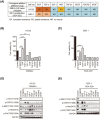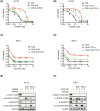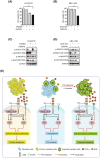Autocrine EGF and TGF-α promote primary and acquired resistance to ALK/c-Met kinase inhibitors in non-small-cell lung cancer
- PMID: 36583451
- PMCID: PMC9801488
- DOI: 10.1002/prp2.1047
Autocrine EGF and TGF-α promote primary and acquired resistance to ALK/c-Met kinase inhibitors in non-small-cell lung cancer
Abstract
Drug resistance severely limits the clinical therapeutic value of molecularly targeted drugs. Growth factors gain a tremendous amount of focus due to the ability to promote drug resistance in non-small-cell lung cancer (NSCLC). However, whether tumor cells themselves can mediate drug resistance by secreting growth factors needs further clarification. Here, we first screened growth factors to identify autocrine epidermal growth factor (EGF) and transforming growth factor alpha (TGF-α) that caused primary resistance to the ALK inhibitor TAE684 in H3122 cells and the c-MET-specific inhibitor SGX-523 in EBC-1 cells. Next, we discovered increased autocrine production of EGF and TGF-α in established acquired resistant H3122/TR and EBC-1/SR cells. Importantly, overexpression of EGF and TGF-α in two NSCLC cell lines produced resistance to TAE684 and SGX-523. Clinically, NSCLC patients with high expression of EGF and TGF-α developed primary resistance to crizotinib. Mechanistically, autocrine EGF and TGF-α activated EGFR signaling pathways to survive targeted c-Met and ALK inhibition. Furthermore, combined treatment with gefitinib circumvented EGF- and TGF-α-mediated primary and acquired resistance to TAE684/SGX-523. Taken together, these results suggested increased autocrine EGF and TGF-α conferred primary and acquired resistance to ALK/c-Met kinase inhibitors in NSCLC.
Keywords: acquired resistance; autocrine growth factor; non-small-cell lung cancer; primary resistance.
© 2022 The Authors. Pharmacology Research & Perspectives published by British Pharmacological Society and American Society for Pharmacology and Experimental Therapeutics and John Wiley & Sons Ltd.
Figures





References
-
- Bray F, Ferlay J, Soerjomataram I, Siegel R, Torre L, Jemal A. Global cancer statistics 2018: GLOBOCAN estimates of incidence and mortality worldwide for 36 cancers in 185 countries. CA Cancer J Clin. 2018;68:394‐424. - PubMed
-
- Maemondo M, Inoue A, Kobayashi K, et al. Gefitinib or chemotherapy for non‐small‐cell lung cancer with mutated EGFR. N Engl J Med. 2010;362:2380‐2388. - PubMed
-
- Mok T, Wu Y, Thongprasert S, et al. Gefitinib or carboplatin‐paclitaxel in pulmonary adenocarcinoma. N Engl J Med. 2009;361:947‐957. - PubMed
-
- Solomon B, Kim D, Wu Y, et al. Final overall survival analysis from a study comparing first‐line Crizotinib versus chemotherapy in ALK‐mutation‐positive non‐small‐cell lung cancer. J Clin Oncol. 2018;36:2251‐2258. - PubMed
-
- Solomon B, Mok T, Kim D, et al. First‐line crizotinib versus chemotherapy in ALK‐positive lung cancer. N Engl J Med. 2014;371:2167‐2177. - PubMed
Publication types
MeSH terms
Substances
LinkOut - more resources
Full Text Sources
Medical
Research Materials
Miscellaneous

